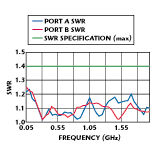Programmable Attenuator Subsystems
Weinschel Corp.
Frederick, MD
Finally there is a low cost, easy-to-use programmable attenuator for use on the test bench or in subsystem applications. The new 8310 series SmartStep attenuator units represent a new concept in programmable attenuation that is both flexible and easy to program. The standard 8310 series attenuator houses and controls various programmable attenuator models (for example, models 3200T and 150T and the 4200 series attenuators) via front-panel controls or standard communications interfaces such as the general-purpose interface bus (GPIB) IEEE-488, RS-232, RS-422 and RS485.
The programmable attenuator series provides a flexible, easy-to-program, low cost solution for benchtop test and calibration setups and subsystem applications. Additional features include multichannel attenuation paths (up to four inputs and outputs), relative vs. nominal attenuation step functions and a wide choice of frequency and attenuation ranges (DC to 1, 2, 3, 18 and 26 GHz and up to 127 dB). The units feature internal relay switched, GaAs FET or PIN solid-state attenuators, providing high accuracy and repeatability. The standard units are designed for 50 W input and output impedance operation, however, 75 W configurations are available.
The 8310 series attenuators are supplied in a 12.00" x 8.38" x 3.47" housing with front-panel control and readout. In addition, the units may be rack mounted either as a single unit using an available rack-mounting kit (part no. 193-8033) or two model 8310 units may be mounted together using a slightly different mounting kit (part no. 193-8033-1). Both kits allow the unit to be easily installed into any rack or cabinet that is designed in accordance with EIA RS-310 or MIL-STD-189. The 8310 units combine the features of the model 8210A device controller with a front-panel user interface to form a flexible, easy-to-use solution.
Most 8310 series units are single-channel configurations where the RF signal is routed through either the front- or rear-mounted ports A and B. However, units may be configured for up to four channels of attenuation, RF switching or other functions. Multiple programmable attenuators may be used in conjunction with other coaxial devices such as switches, power combiners, directional couplers and filters, creating single- or multichannel subsystems.
Applications for the 8310 series attenuators range from providing control of a single SmartStep attenuator in a bench test or lab environment using a PC and a terminal emulator to complex multichannel system applications where the 8310 unit is employed to control many devices to create custom subsystems to reduce design cost and increase flexibility. A variety of custom-designed driver interfaces for various devices, such as RF switches, relays, PIN attenuators, motorized step attenuators and displays, may be supplied.
Specific Model Performances
 The model 8310-37-2-F attenuator represents a typical example of the 8310 series units. It provides programmable attenuation in 0.25 dB steps to 63.75 dB over the DC to 2 GHz frequency range, as shown in Figure 1 . Maximum insertion loss is 6 dB, and input and output SWR is 1.4 (max). Figures 2 and 3 show the attenuator's typical insertion loss and input/output SWR performance vs. frequency, respectively. The unit features two channels and utilizes model 3200T-2 attenuators internally. N-type female connectors are mounted on both the front and rear panels.
The model 8310-37-2-F attenuator represents a typical example of the 8310 series units. It provides programmable attenuation in 0.25 dB steps to 63.75 dB over the DC to 2 GHz frequency range, as shown in Figure 1 . Maximum insertion loss is 6 dB, and input and output SWR is 1.4 (max). Figures 2 and 3 show the attenuator's typical insertion loss and input/output SWR performance vs. frequency, respectively. The unit features two channels and utilizes model 3200T-2 attenuators internally. N-type female connectors are mounted on both the front and rear panels.

 The model 8310-38-3-T unit provides 63 dB of attenuation in 1 dB steps from DC to 2 GHz. This unit has three channels utilizing the model 3206T-1 attenuator and has N-type female connectors at both the front and rear panels. Insertion loss is 5.25 dB (max) and SWR is 1.4 (max).
The model 8310-38-3-T unit provides 63 dB of attenuation in 1 dB steps from DC to 2 GHz. This unit has three channels utilizing the model 3206T-1 attenuator and has N-type female connectors at both the front and rear panels. Insertion loss is 5.25 dB (max) and SWR is 1.4 (max).
The model 8310-202-R utilizes two 150T programmable attenuators to provide 121 dB of attenuation in 1 dB steps from DC to 18 GHz. Here, the connectors are SMA female on the rear panel. Insertion loss is 5.25 dB (max) and SWR is 1.95 (max).
Many additional models are available to provide different attenuation levels, resolutions, frequency ranges and configurations to suit the needs of a variety of applications. (A complete listing is provided in the 8310 series data sheet.) All models require 100 to 240 V AC at 50/60 Hz and 50 W and operate over a temperature range of 0° to +50°C. In addition, each unit features an IEEE-488 bus interface utilizing a 24-pin IEEE-488-1 connector and appropriate protocols, an RS-232 bus interface with a nine-pin male D connector, and RS-422 and RS-485 interfaces also utilizing a nine-pin male D connector. Additional information may be obtained from the company's Web site at www.weinschel.com.
Weinschel Corp.,
Frederick, MD
(301) 846-9222.
